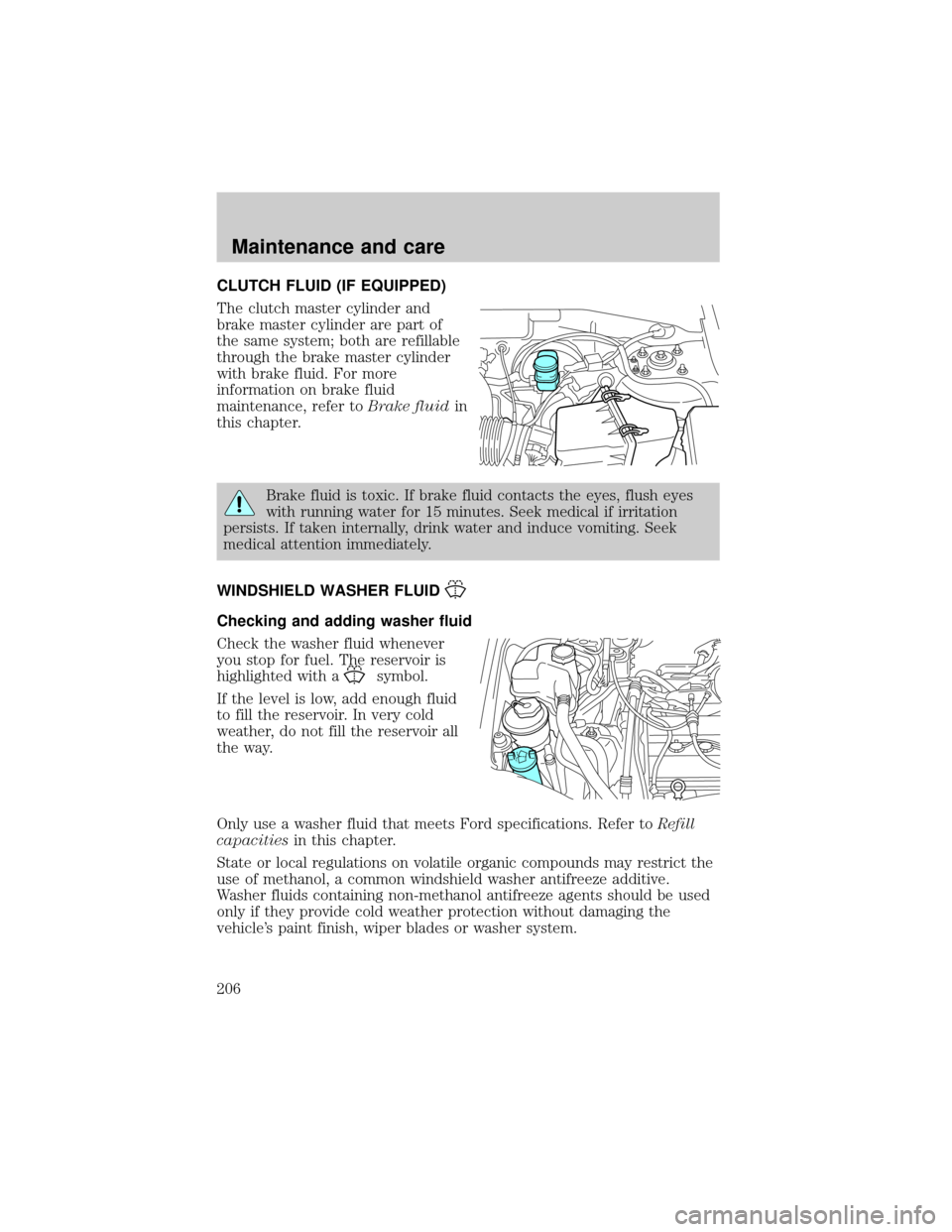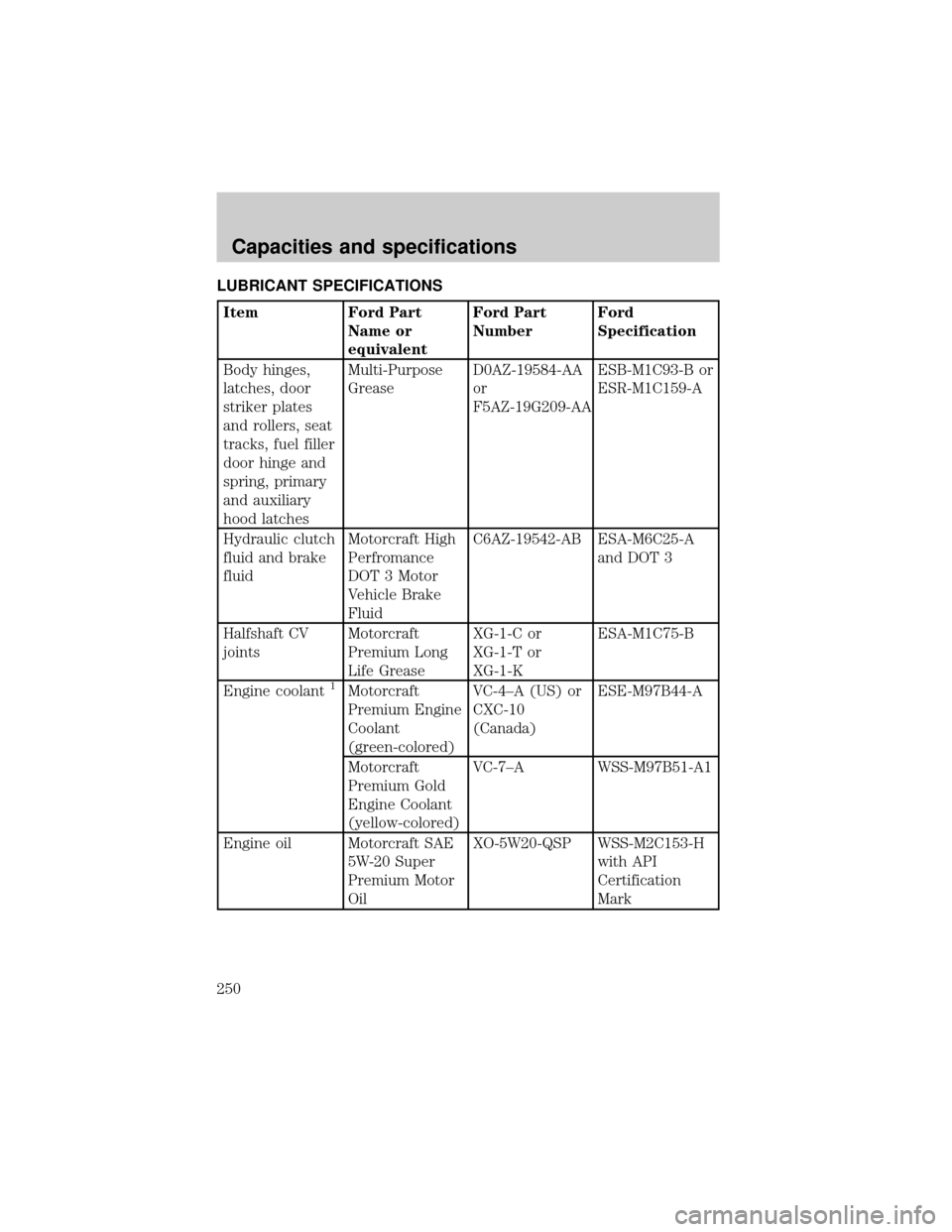2001 FORD ESCAPE brake fluid
[x] Cancel search: brake fluidPage 206 of 280

CLUTCH FLUID (IF EQUIPPED)
The clutch master cylinder and
brake master cylinder are part of
the same system; both are refillable
through the brake master cylinder
with brake fluid. For more
information on brake fluid
maintenance, refer toBrake fluidin
this chapter.
Brake fluid is toxic. If brake fluid contacts the eyes, flush eyes
with running water for 15 minutes. Seek medical if irritation
persists. If taken internally, drink water and induce vomiting. Seek
medical attention immediately.
WINDSHIELD WASHER FLUID
Checking and adding washer fluid
Check the washer fluid whenever
you stop for fuel. The reservoir is
highlighted with a
symbol.
If the level is low, add enough fluid
to fill the reservoir. In very cold
weather, do not fill the reservoir all
the way.
Only use a washer fluid that meets Ford specifications. Refer toRefill
capacitiesin this chapter.
State or local regulations on volatile organic compounds may restrict the
use of methanol, a common windshield washer antifreeze additive.
Washer fluids containing non-methanol antifreeze agents should be used
only if they provide cold weather protection without damaging the
vehicle's paint finish, wiper blades or washer system.
Maintenance and care
206
Page 214 of 280

5. If the fluid is low, add fluid in small amounts, continuously checking
the level until it reaches the range between the MIN and MAX lines. Be
sure to put the cap back on the reservoir.
TRANSMISSION FLUID
Checking automatic transmission fluid (if equipped)
Refer to your scheduled maintenance guide for scheduled intervals for
fluid checks and changes. Your transaxle does not consume fluid.
However, the fluid level should be checked if the transaxle is not working
properly, i.e., if the transaxle slips or shifts slowly or if you notice some
sign of fluid leakage.
Automatic transmission fluid expands when warmed. To obtain an
accurate fluid check, drive the vehicle until it is warmed up
(approximately 30 km [20 miles]). If your vehicle has been
operated for an extended period at high speeds, in city traffic
during hot weather or pulling a trailer, the vehicle should be
turned off for about 30 minutes to allow fluid to cool before
checking.
1. Drive the vehicle 30 km (20 miles) or until it reaches normal operating
temperature.
2. Park the vehicle on a level surface and engage the parking brake.
3. With the parking brake engaged and your foot on the brake pedal,
start the engine and move the gearshift lever through all of the gear
ranges. Allow sufficient time for each gear to engage.
4. Latch the gearshift lever in P (Park) and leave the engine running.
5. Remove the dipstick, wiping it clean with a clean, dry lint free rag. If
necessary, refer toIdentifying components in the engine compartment
in this chapter for the location of the dipstick.
6. Install the dipstick making sure it is fully seated in the filler tube.
7. Remove the dipstick and inspect the fluid level. The fluid should be in
the crosshatch zone for normal operating temperature.
Low fluid level
Do not drive the vehicle if the fluid
level is at the bottom of the dipstick
and the outside temperatures are
above 10ÉC (50ÉF).
Maintenance and care
214
Page 242 of 280

Washing your vehicle
Wash your vehicle regularly with
cold or lukewarm water. Never use
strong detergents or soap. If your
vehicle is particularly dirty, use a
quality car wash detergent. Always
use a clean sponge, washing glove
or similar device and plenty of water
for best results. To avoid spots,
avoid washing when the hood is still
warm, immediately after or during
exposure to strong sunlight.
During winter months, it is especially important to wash the vehicle on a
regular basis. Large quantities of dirt and road salt are difficult to
remove and also cause damage to the vehicle.
Any gasoline spilled on the vehicle or deposits such as bird droppings
should be washed and sponged off as soon as possible. Deposits not
removed promptly can cause damage to the vehicle's paintwork.
Remove any exterior accessories, such as antennas, before entering a car
wash. If you have wax applied to the vehicle at a commercial car wash, it
is recommended that you clean the wiper blades and windshield as
described inCleaning the wiper blades and windshield.
After washing, apply the brakes several times to dry them.
Underbody
Flush the complete underside of vehicle frequently. Keep body drain
holes unplugged. Inspect for road damage.
Waxing your vehicle
Waxing your vehicle on a regular basis will reduce minor scratches and
paint damage.
Wax when water stops beading on the surface. This could be every three
or four months, depending on operating conditions.
Use only carnauba or synthetic-based waxes. Use a cleaning fluid with a
clean cloth to remove any bugs before waxing your vehicle. Use tar
remover to remove any tar spots.
Maintenance and care
242
Page 247 of 280

MOTORCRAFT PART NUMBERS
Component 2.0L DOHC I4
Zetec engine3.0L DOHC V6 Duratec
engine
Air filter element
1FA-1683 FA-1683
Fuel filter FG-800-A FG-800-A
Battery BXT-96R BXT-40R
Oil filter FL-400S FL-820-S
PCV valve EV-224 EV-243
Spark plugs*
2AZFS-32FE3AGSF-32W
1Failure to use the correct air filter element may result in severe engine
damage. The customer warranty may be voided for any damage to the
engine if the correct air filter element is not used.
2Refer to Vehicle Emissions Control Information (VECI) decal for spark
plug gap information.
3If a spark plug is to be removed for inspection, it must be reinstalled in
the same cylinder. If a spark plug needs to be replaced, use only spark
plugs with the service part number suffix letter as shown on the engine
decal.
REFILL CAPACITIES
Fluid Ford Part
NameApplication Capacity
Brake fluid Motorcraft High
Performance
DOT 3 Motor
Vehicle Brake
FluidAll Fill to line on
reservoir
Engine oil
(including filter
change)Motorcraft SAE
5W-20 Super
Premium Motor
Oil2.0L I4 Zetec
engine4.25L (4.5
quarts)
3.0L V6 Duratec
engine5.2L (5.5
quarts)
Fuel tank N/A 2.0L I4 Zetec
engine57L (15 gallons)
3.0L V6 Duratec
engine61L (16 gallons)
Capacities and specifications
247
Page 250 of 280

LUBRICANT SPECIFICATIONS
Item Ford Part
Name or
equivalentFord Part
NumberFord
Specification
Body hinges,
latches, door
striker plates
and rollers, seat
tracks, fuel filler
door hinge and
spring, primary
and auxiliary
hood latchesMulti-Purpose
GreaseD0AZ-19584-AA
or
F5AZ-19G209-AAESB-M1C93-B or
ESR-M1C159-A
Hydraulic clutch
fluid and brake
fluidMotorcraft High
Perfromance
DOT 3 Motor
Vehicle Brake
FluidC6AZ-19542-AB ESA-M6C25-A
and DOT 3
Halfshaft CV
jointsMotorcraft
Premium Long
Life GreaseXG-1-C or
XG-1-T or
XG-1-KESA-M1C75-B
Engine coolant
1Motorcraft
Premium Engine
Coolant
(green-colored)VC-4±A (US) or
CXC-10
(Canada)ESE-M97B44-A
Motorcraft
Premium Gold
Engine Coolant
(yellow-colored)VC-7±A WSS-M97B51-A1
Engine oil Motorcraft SAE
5W-20 Super
Premium Motor
OilXO-5W20-QSP WSS-M2C153-H
with API
Certification
Mark
Capacities and specifications
250
Page 270 of 280

A
Air bag supplemental restraint
system ........................118±119, 124
and child safety seats ............121
description ......................119, 124
disposal ....................................127
driver air bag ..................121, 125
indicator light ...........11, 123, 126
operation .........................121, 125
passenger air bag ...........121, 125
side air bag ..............................124
Air cleaner filter ...............207, 247
Air conditioning ..........................21
All Wheel Drive (AWD),
driving off road ...................20, 150
Ambulance packages ....................5
Antifreeze (see Engine
coolant) .....................................208
Anti-lock brake system (see
Brakes) ..............................142±143
Anti-theft system ........................95
arming the system ....................96
disarming a triggered system ..96
warning light .............................13
Audio system (see Radio) ...26, 54
Automatic transaxle .................146
driving with .............................147
fluid, adding ............................214
fluid, checking ........................214
Automatic transmission
fluid, refill capacities ..............247
fluid, specification ..................252
Auxiliary power point .................85
Axle
lubricant specifications ..250, 252
refill capacities ........................247B
Battery .......................................216
acid, treating emergencies .....216
charging system warning light 13
jumping a disabled battery ....188
maintenance-free ....................216
replacement, specifications ...247
servicing ..................................216
Belt minder ...............................113
Brakes ........................................142
anti-lock ...........................142±143
anti-lock brake system (ABS)
warning light .....................12, 142
brake warning light ..................12
fluid, checking and adding ....205
fluid, refill capacities ..............247
fluid, specifications .........250, 252
lubricant specifications ..250, 252
parking ....................................143
shift interlock ..........................146
Break-in period .............................3
C
Capacities for refilling fluids ....247
Cargo cover .................................86
Cargo net .....................................86
Certification Label ....................254
Child safety restraints ..............127
child safety belts ....................127
Child safety seats ......................128
attaching with tether straps ..132
in front seat ............................129
in rear seat ..............................129
LATCH .....................................134
Cleaning your vehicle ...............241
engine compartment ..............243
Index
270
Page 274 of 280

Load limits .................................155
GAWR ......................................155
GVWR ......................................155
trailer towing ..........................155
Loading instructions .................156
Locks
childproof ..................................84
Lubricant specifications ...250, 252
Lumbar support, seats .............100
M
Manual transaxle
fluid, checking and adding ....216
Manual transmission
fluid capacities ........................247
lubricant specifications ..........252
Mirrors
cleaning ...................................246
fold away ...................................20
side view mirrors (power) .......19
Moon roof ....................................79
Motorcraft parts ................230, 247
O
Octane rating ............................227
Odometer .....................................18
Off-Road Driving .......................152
Oil (see Engine oil) ..................201
Overdrive ...................................146
P
Panic alarm feature, remote
entry system ................................90
Parking brake ............................143Parts (see Motorcraft parts) ....247
Power distribution box (see
Fuses) ........................................180
Power door locks ........................84
Power steering ..........................144
fluid, checking and adding ....213
fluid, refill capacity ................247
fluid, specifications .........250, 252
Preparing to drive your
vehicle ........................................145
R
Radio ............................................26
Rear window defroster ...............20
Relays ........................................176
Remote entry system ...........89±90
illuminated entry ......................92
locking/unlocking doors ...........90
panic alarm ...............................90
replacement/additional
transmitters ...............................91
replacing the batteries .............91
Roof rack ...................................162
S
Safety belts (see Safety
restraints) ....................15, 107±111
Safety defects, reporting ..........269
Safety restraints ................107±111
belt minder .............................113
cleaning the safety
belts .................................117, 246
extension assembly ................112
for adults .........................108±110
for children .............................127
lap belt ....................................112
Index
274